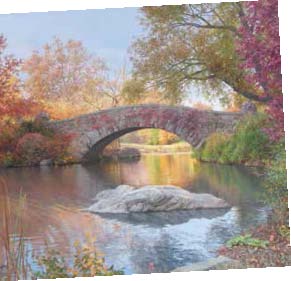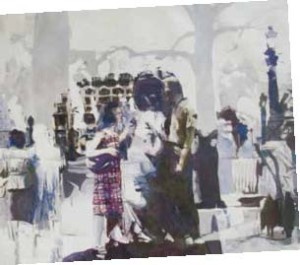New York, New York – Ask the Artsperts
 by Juliana Meek and Kristine Meek
by Juliana Meek and Kristine Meek
Dear Artspert:
Why is New York City considered the center of the art world?
Signed,
Big Apple Art

“BISTRO, MADISON AVE” BY JESSICA DARYL WINER, WATERCOLOR AND INK, 22” X 30”
Dear Big Apple Art,
New York City wasn’t always considered the center of the art world. It garnered that distinction by 1955 from the previous destination for art lovers – Paris, France. Paris had controlled the art scene since the advent of French Impressionism in the 19th century. This movement was a radical change in the way art was created and appreciated and it is this very type of occurrence in the art world that causes a shift not only in the artwork but also in the geographical location of where artists tend to congregate.
French Impressionism broke the long held “rules” for what constituted art just the way the New York School of “Abstract Expressionism” did in 1951. Post-war American art struggled to find what direction to turn after two decades of control by the “American Regionalists” such as Grant Wood, Thomas Hart Benton, Clarence H. Carter, Adolf Dehn, Aaron Bohrod, Reginald Marsh, and John Stuart Curry. By 1951 the direction was pointed forward by the likes of Adolf Gottlieb, Franz Kline, Mark Rothko, Jimmy Ernst, Ibram Lassaw, Willem de Kooning, Jackson Pollack, Robert Rauschenberg and scores of others. This new art also played a political role perfect for the McCarthy era of anti-communist sentiment. The communist countries of Russia, China, and of Eastern Europe encouraged artists to created very mundane realistic images of workers providing for the common good. While here in America, artists were free to paint any way they chose and to break conventional rules of art.

“GAPSTOW BRIDGE, CENTRAL PARK”
BY JOHN FALATO, OIL ON PANEL,
11” X 14”, 2014
With this new wave of artists came new museums and hundreds of new art galleries, mostly centered in the metropolitan New York City area. In the early 1950’s, there already existed the foundation of a few prominent galleries that had survived depression and war years. There were also the three modern museums: Whitney, MOMA, and Guggenheim along with the well established and traditional MET. With this solid foundation, New York had all it needed to take control of the art world.
By 1960 this new wave of artists would be followed by successive decades long New York art movements which kept attention flowing in and out of the city. These were: “Pop art,” “Op Art,” “Minimalism”, “Color Field,” “Photorealism,” and “New Realism” all in subsequent movements since the 1960s. New York City was the measuring stick for all art by 1970. “If you can make it in New York you can make it anywhere”.
Images of New York City’s varied environment have enabled artists to focus on whatever they liked from graffiti art on subways and walls to paintings of Central Park. If this inspires you to get a taste of New York in Naples, January 11 – 22 Harmon-Meek Gallery will have the one-women exhibition of New York artist, Jessica Daryl Winer, as well as a special group exhibition of paintings depicting scenes of Central Park.
Sincerely,
The Artsperts

“THE CITY EARLY SPRING”
BY BALCOMB GREENE, OIL ON CANVAS,
48” X 60”, 1979


Leave a Reply
Want to join the discussion?Feel free to contribute!